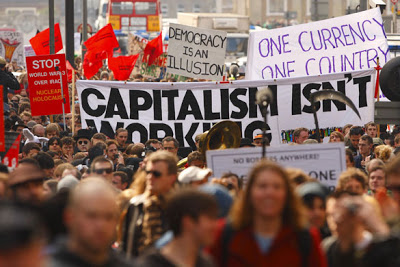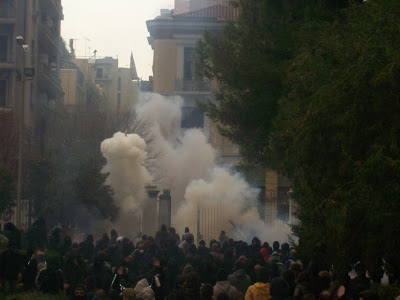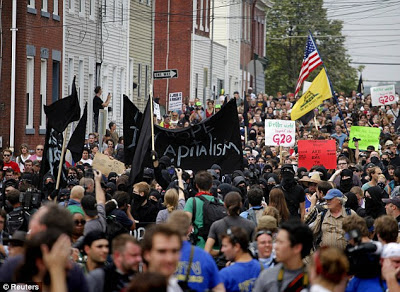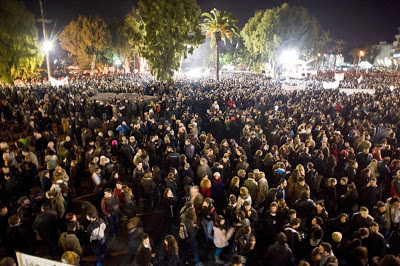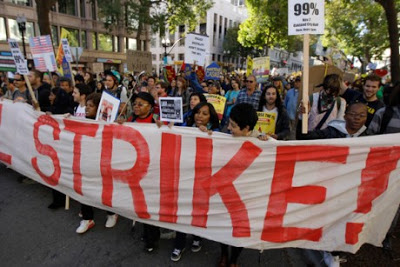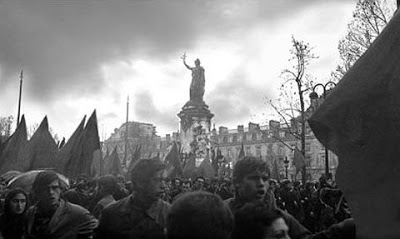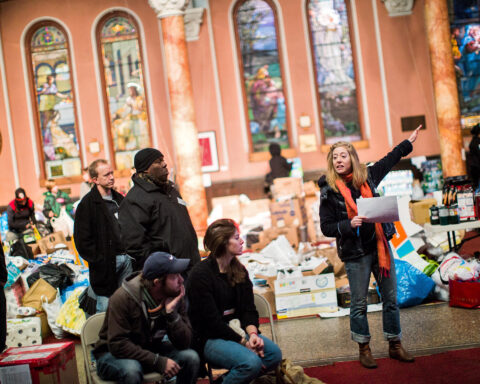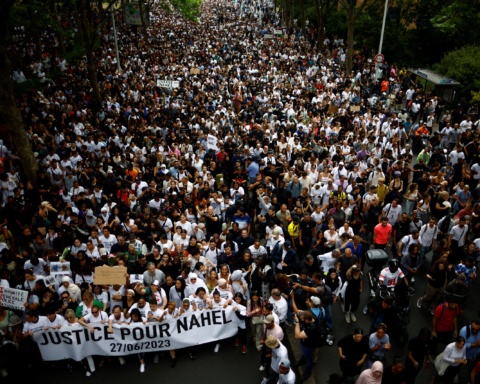Doing In-Against-and-Beyond Labour ,
By John Holloway
(1)
At the heart of the social movements of recent years, at least in their more radical variants, is a drive against the logic of capitalist society. The so-called social movements are not organised as parties: their aim is not to take state power. The goal is rather to reverse the movement of a society gone mad, systematically mad. The movements say in effect “No, we refuse to go in that direction, we refuse to accept the mad logic of the capitalist system, we shall go in a different direction, or in different directions.”
The anti-capitalist movements of recent years give a new meaning to revolution. Revolution is no longer about taking power, but about breaking the insane dynamic that is embedded in the social cohesion of capitalism. The only way of thinking of this is as a movement from the particular, as the puncturing of that cohesion, as the creation of cracks in the texture of capitalist social relations, spaces or moments of refusal-and-creation. Revolution, then, becomes the creation, expansion, multiplication and confluence of these cracks.(1)
How do we conceptualise this sort of revolution? By going back to a category that was of central importance for Marx, but has been almost completely forgotten by his followers. This is the dual character of labour, the distinction between abstract and concrete labour.
The social cohesion of capitalism against which we revolt is constituted by abstract labour: not by money, not by value, but by the activity that generates the value and money forms, namely abstract labour. To crack the social cohesion of capitalism is to confront the cohesive force of abstract labour with a different sort of activity, an activity that does not fit in to abstract labour, that is not wholly contained within abstract labour.
(2)
This is not a dry theoretical point, for the starting point for considering the relationship between abstract and concrete labour is and must be rage, the scream. This is empirically true: that is actually where we start from. And also, rage is key to theory. It is rage which turns complaint into critique because it reminds us all the time that we do not fit, that we are not exhausted in that which we criticise. Rage is the voice of non-identity, of that which does not fit. The criticism of capitalism is absolutely boring if it is not critique ad hominem: if we do not open the categories and try to understand them, not just as fetishised expressions of human creative power, but as categories into which we do not fit, categories from which we overflow. Our creativity is contained and not contained in the social forms that negate it. The form is never adequate to the content. The content misfits the form: that is our rage, and that is our hope. This is crucial theoretically and politically.
(3)
In recent years, it has become more common to cite Marx’s key statement in the opening pages of Capital. “this point [the two-fold nature of the labour contained in commodities] is the pivot on which a clear comprehension of Political Economy turns” (1867/1965:41). After the publication of the first volume, he wrote to Engels (Marx, 1867/1987:407): “The best points in my book are: 1) the two-fold character of labour, according to whether it is expressed as use value or exchange value. (All understanding of the facts depends upon this. It is emphasised immediately in the first chapter).”
It is important to emphasise this statement, against the Marxist tradition which buried it for so long, and with quite extraordinary success. It is important to emphasise it because it takes us to the core of Marx’s critique ad hominem, understanding the world in terms of human action and its contradictions. The two-fold nature of labour refers to abstract and concrete or useful labour. Concrete labour, according to Marx, is the activity that exists in any form of society, the activity that is necessary for human reproduction. Arguably, Marx was mistaken in referring to this as labour, since labour as an activity distinct from other activities is not common to all societies, so it seems more accurate to speak of concrete doing rather than concrete labour. In capitalist society, concrete doing (what Marx calls concrete labour) exists in the historically specific form of abstract labour. Concrete labours are brought into relation with other concrete labours through a process which abstracts from their concrete characteristics, a process of quantitative commensuration effected normally through the medium of money, and this process of abstraction rebounds upon the concrete labour transforming it into an activity abstracted from (or alienated from) the person performing the activity.
(4)
It is thus the abstraction of our activity into abstract labour that constitutes the social cohesion of capitalist society. This is an important advance on the concept of alienated labour developed in the 1844 manuscripts: capitalist labour is not only an activity alienated from us, but it is this alienation or abstraction that constitutes the social nexus in capitalism. The key to understanding the cohesion (and functioning) of capitalist society is not money or value, but that which constitutes value and money, namely abstract labour. In other words we create the society that is destroying us, and that is what makes us think that we can stop making it.
Abstract labour as a form of activity did not always exist. It is a historically specific form of concrete doing that is established as the socially dominant form through the historical process generally referred to as primitive accumulation. The metamorphosis of human activity into abstract labour is not restricted to the workplace but involves the reorganisation of all aspects of human sociality: crucially, the objectification of nature, the homogenisation of time, the dimorphisation of sexuality, the separation of the political from the economic and the constitution of the state, and so on.
(5)
If we say that revolution is the breaking of the social cohesion of capitalism and that that cohesion is constituted by abstract labour, the question then is how we understand the solidity of that cohesion. In other words, how opaque is the social form of abstract labour?
Or, rephrasing the same question in other words, is primitive accumulation to be understood simply as a historical phase that preceded capitalism? If we say (as Postone (1996) does) that labour is the central fetish of capitalist society, then how do we understand that fetish?
Marx, in the passage quoted above, refers to the dual character of labour as the key to an understanding of political economy. He does not refer just to abstract labour but to the dual character of labour as abstract and concrete labour, and yet the commentaries that focus on this point concentrate almost exclusively on abstract labour, assuming that concrete labour (concrete doing) is unproblematic since it is entirely subsumed within abstract labour, and can simply be discussed as productivity. This implies that primitive accumulation is to be understood as a historical phase that was completed in the past, effectively establishing abstract labour as the dominant form of concrete labour, thus separating the constitution of capitalism from its existence. It implies the understanding of form and content as a relation of identity in which content is completely subordinated to form until the moment of revolution. This establishes a clear separation between the past (in which concrete doing existed independent of its abstraction) and the present (in which doing is entirely subsumed within its form), effectively enclosing the analysis of the relation between concrete doing and abstract labour within the homogenous concept of time that is itself a moment of abstract labour. This takes us inevitably to a view of capital as a relation of domination (rather than a contested relation of struggle) and therefore to a view of revolution as something that would have to come from outside the capital relation (from the Party, for example).
However, it is not adequate to understand the relation between abstract labour and concrete doing as one of domination. Rather, abstract labour is a constant struggle to contain concrete doing, to subject our daily activity to the logic of capital. Concrete doing exists not just in but also against and beyond abstract labour, in constant revolt against abstract labour. This is not to say that there is some transhistorical entity called concrete doing, but that in capitalist society concrete doing is constituted by its misfitting, by its non-identity with abstract labour, by its opposition to and overflowing from abstract labour.
This means that there can be no clear separation between the constitution and the existence of the capitalist social relations. It is not the case that capitalist social relations were first constituted in the period of primitive accumulation or the transition from feudalism, and that then they simply exist as closed social relations. If concrete doing constantly rebels against and overflows beyond abstract labour, if (in other words) our attempt to live like humans constantly clashes with and ruptures the logic of capitalist cohesion, then this means that the existence of capitalist social relations depends on their constant reconstitution, and that therefore primitive accumulation is not just an episode in the past. If capitalism exists today, it is because we constitute it today, not because it was constituted two or three hundred years ago. If this is so, then the question of revolution is radically transformed. It is not: how do we abolish capitalism? But rather, how do we cease to reconstitute capitalism, how do we stop creating capitalism? The answer is clear (but not easy): by ceasing to allow the daily transformation of our doing, our concrete activity, into abstract labour, by developing an activity that does not recreate capitalist social relations, an activity that does not fit in with the logic of the social cohesion of capitalism.
(6)
This might seem absurd, were it not for the fact that the revolt of concrete doing against abstract labour is all around us. Sometimes it takes dramatic proportions when a group like the Zapatistas says “no, we will not act according to the logic of capital, we shall do what we consider important at the rhythm that we consider appropriate.” But of course it does not have to be on such a large scale: the revolt of doing against abstract labour and the determinations and rhythms that it imposes upon us is deeply rooted in our everyday lives. Pannekoek said of the workplace that “every shop, every enterprise, even outside of times of sharp conflict, of strikes and wage reductions, is the scene of a constant silent war, of a perpetual struggle, of pressure and counter-pressure” (2005:5).(2) But it is not just in the workplace: life itself is a constant struggle to break through the connections forged by abstract labour to create other sorts of social relations: when we refuse to go to work so that we can stay and play with the children, when we read (or write) an article like this, when we choose to do something not because it will bring us money but just because we enjoy it or consider it important. All the time we oppose use value to value, concrete doing to abstract labour. It is from these revolts of everyday existence, and not from the struggles of activists or parties that we must pose the question of the possibility of ceasing to create capitalism and creating a different sort of society.
(7)
Not only is there a constant revolt of concrete against abstract labour, but there is now a crisis of abstract labour. Abstract labour cannot be understood as something stable: its rhythms are shaped by socially necessary labour time. Since abstract labour is value-producing labour and value production is determined by socially necessary labour time, there is a constant redefinition of abstract labour: abstract labour is a constant compulsion to go faster, faster, faster. Abstract labour constantly undermines its own existence: an activity that produced value a hundred (or ten, or five) years ago no longer produces value today. Abstraction becomes a more and more exigent process, and it becomes harder and harder for people to keep pace with it: more and more of us misfit, and more and more of us consciously revolt against abstract labour. Abstraction becomes an ever greater pressure, but at the same time it becomes a more and more inadequate form of organising human activity: abstraction is not able to channel effectively the activities of a large part of humanity.
The dynamic of abstraction comes up increasingly against a resistance that splits open the apparently unitary concept of labour and poses the struggle against abstract labour at the centre of anti-capitalist struggle. Anti-capitalist struggle becomes the assertion of a different way of doing, a different way of living; or rather, the simple assertion of a different way of doing (I want to spend time with my friends, with my children, I want to be a good teacher, carpenter, doctor and work at a slower pace, I want to cultivate my garden) becomes converted into anti-capitalist struggle. The survival of capital depends on its ability to impose (and constantly redefine) abstract labour. The survival of humanity depends on our ability to stop performing abstract labour and do something sensible instead. Humanity is simply the struggle of doing against labour.
(8)
It is in the context of the crisis of abstract labour that the discussion of abstract labour acquires importance. It is important, that is, if we focus not just on abstract labour, but on the dual character of labour, the antagonism between doing and labour. If we focus just on abstract labour and forget concrete doing, then we just develop a more sophisticated picture of capitalist domination, of how capitalism works. Our problem, however, is not to understand how capitalism works but to stop creating and recreating it. And that means strengthening doing in its struggle against labour.
It is not theory that brings about the splitting of the unitary concept of labour. The splitting of the unitary concept has been the result of struggle. It is a multitude of struggles, large and small, that have made it clear that it makes little sense to speak just of “labour”, that we have to open up “labour” and see that the category conceals the constant tension-antagonism between concrete doing (doing what we want, what we consider necessary or enjoyable) and abstract labour (value-producing, capital-producing labour). It is struggle that splits open the category, but theoretical reflection (understood as a moment of struggle) has an important role to play in keeping the distinction open.
This is important at the moment when there are so many pressures to close the category, to forget about the antagonism the category conceals, to dismiss the notion that there could be some form of activity other than abstract labour as silly, romantic, irresponsible. In capitalist society, access to the means of production and survival usually depends upon our converting our activity, our doing, into labour in the service of capital, abstract labour. We are now at a moment in all the world in which capital is unable to convert the activity of millions and millions of people (especially young people) into labour, other than on a very precarious basis. Given that exclusion from labour is generally associated with material poverty, do we now say to capital “please give us more employment, please convert our doing into labour, we will happily labour faster-faster-faster”? This is the position of the trade unions and many left political parties, as it must be, for they are organisations based on abstract labour, on the suppression of the distinction between labour and doing. Or do we say “no, we cannot go that way (and we do not ask anything of capital). We know that the logic of faster-faster-faster will lead to ever bigger crises, and we know that, if it continues, it will probably destroy human existence altogether. For this reason we see crisis and unemployment and precariousness as a stimulus to strengthen other forms of doing, to strengthen the struggle of doing against labour.” There is no easy answer here, and no pure solution, because our material survival depends, for most of us, on subordinating our activity to some degree to the logic of abstraction. But it is essential to keep the distinction open and find ways forward, to strengthen the insubmission of doing to labour, to extend the rupture of labour by doing. That is the only way in which we can stop reproducing the system that is killing us.
John Holloway is a Professor in the Instituto de Ciencias Sociales y Humanidades of the Benemérita Universidad Autónoma de Puebla in Mexico. His publications include Crack Capitalism (Pluto, 2010), Change the World Without Taking Power (Pluto, 2005), Zapatista! Reinventing Revolution in Mexico (co-editor, Pluto, 1998) and Global Capital, National State and the Politics of Money (co-editor, Palgrave Macmillan, 1994).
Notes:
(1) For a development of this argument, see my forthcoming book, Crack Capitalism.
(2) I take the quote from Shukaitis (2009:15).
References:
Holloway, John (2010) Crack Capitalism (London: Pluto Press)
Marx, Karl (1867/1965), Capital, Vol. 1 (Moscow: Progress Publishers)
Marx, Karl (1867/1987), ‘Letter of Marx to Engels, 24.8.1867’, in Karl Marx & Friedrich Engels, Collected Works vol. 42 (London: Lawrence & Wishart), p. 407
Pannekoek, Anton (2005) Workers’ Councils (Oakland: AK Press)
Postone, Moishe (1996) Time, Labour, and Social Domination: A reinterpretation of Marx’s critical theory (Cambridge: Cambridge University Press)
Shukaitis, Stevphen (2009) Imaginal Machines: Autonomy and Self-Organisation in the Revolutions of Everyday Life (New York: Autonomedia)
